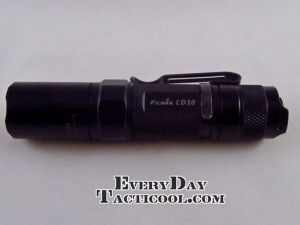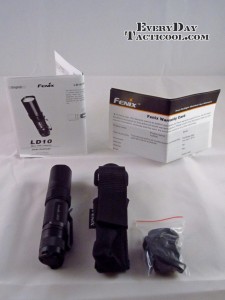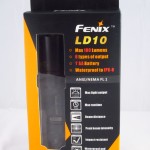Do you ever find your self in the dark? Not the metaphorical darkness, I mean a power outage, or place with little or no available light. We recently had a rash of power outages at the office and the emergency lights did just fine to get everyone out of the building. During a power failure at home I tried to look for two flashlights I keep for black outs. I knew I had the lights but couldn’t see in the drawer or the toolbox they live in. Time to carry a flash light, I suppose.
The other place I often find I need a light is my outdoor rifle range. The shooting benches are closed in on three sides plus the roof. This is great for keeping the weather out, but when we stop shooting at dusk, it can be awfully dark by the time I’m finally packed up.
I picked up a Fenix LD10 light for everyday carry to address the few times I find myself in the dark.
What I Bought
I purchased a Fenix LD10, which can be had for about $85 CAD on amazon.ca, but is often available for less. Included in the package is a belt pouch, lanyard, spare O ring, pocket clip (pre-installed), manual, and warranty card.
Specs
Body: Aircraft-grade aluminum
Finish: Type III hard-anodized anti-abrasive
Weight: 54 g
Length: 10 cm
Diameter: 2.1 cm
Battery type: AA
Waterproof
Modes
General Mode
| Mode | Brightness | Run-time |
| High | 45 Lumens | 4 hours 40 mins |
| Mid | 13 Lumens | 11 hours |
| Low | 3 Lumens | 70 hours |
| SOS | 45 Lumens |
Turbo Mode
| Mode | Brightness | Run-time |
| Turbo | 100 Lumens | 1 hour 45 Minutes |
| Strobe | 100 Lumens |
What I Thought
Overall I am very happy with this light. The LD10 is just about as big around as a C size battery and is a littler shorter then two AAs end to end. The 100 lumen setting in Turbo Mode is ridiculously, blindingly bright. In my completely non-scientific test I ran the Fenix LD10 in Turbo Mode with a new Duracell AA battery and it lasted a little more then 90 minutes. That’s pretty darn close to the advertised run time.
- Fenix LD10 Package Front
- Fenix LD10 Package Rear
Operation is a little weird but it works well for me. With the bezel (where the reflector and led are housed) screwed in tight to the body, the LD10 is in Turbo Mode. Pressing the tail cap switch turns it on. Pressing it again turns it off. Then we get some interesting functions. If you press the switch again within a few seconds the LD10 will come back on in Strobe Mode. Waiting more then a few seconds between turning it off and on again it will just go back to Turbo. You can also go from Turbo to Strobe and back by gently squeezing, not fully depressing, the switch.
General mode is active with the bezel slightly unscrewed, not loose, just not tightened down 100%, 1/32 of a turn is more then enough to put the LD10 in General Mode. I have no fears that the bezel will unscrew enough on its own that it will ever full apart when I take it out of my pocket. In General Mode turning the LD10 on puts it to the dimmest setting, Low. Turning it off and on again in a few seconds will put the light in Mid. Just like Turbo mode if you leave it off for more then a few settings it goes back to the beginning, in General Mode this is Low. You can step through the General Mode brightness by gently squeezing, not fully depressing, the switch. It goes through Low, Mid, High, SOS, and then repeats starting at Low again.
SOS is the only setting I really dislike. I don’t see any reason for this. Maybe if I were lost in the woods and trying to signal a plane or a passing car – maybe. I’d rather just turn Turbo mode on and off 3 times to signal an emergency. Strobe isn’t the most practical mode either but I can at least see that being useful in disorienting another person. If it were up to me, I’d remove those two blinky modes; Strobe, and SOS, and just have the LD10 step through Low, Mid, High, and Turbo. Since I’m using this for EDC when I need illumination and not fighting of assailants in an alley, I keep it in my pocket in General Mode. The few times Low doesn’t give enough light I usual step through general. The 100 Lumen setting is not practical in most situations inside the house. Now lighting up something 100 yards away at night, that’s where Turbo mode excels.
The pocket clip is very robust and can be easily removed. Since I usually carry the Fenix LD10 in a pocket I’ve keep the pocket clip on. I don’t use the belt pouch or lanyard that were included. If I’m carrying the LD10 and its not in my pocket I’m probably running my Tactical Tailor MAV rig and keep the LD10 in my Tactical Tailor Admin Pouch Enhanced.
After a few months of use the hard anodized black finish has held up well. The body and most of the tail cap is checkered, which aids in grip. On a flat surface the LD10 can stand on either end. The bezel assembly has a series of flats around its circumference that keep the light from rolling.
Pros
- Small
- Lightweight
- Ridiculously bright
- Does not roll away
- Run time
Neutral
- Strobe and SOS modes
- Price
Cons
- None?
Buy it on Amazon |
 |
| Fenix LD10 100 Lumens Waterproof LED Flashlight |
Bottom Line
I am very happy with the LD10 from Fenix. Its not super small – some Fenix lights are just a little bigger then a AAA battery – but it provides a good range of brightness, and a good amount of run time. The LD10 operates on a single AA battery, which is inexpensive and easy to find when it needs to be replaced. At $85 its not the cheapest nor most expensive, I think for the feature set and that the LD10 is often available at closer to $50, it’s reasonable. This is a nearly perfect everyday carry flashlight for me. It’s not a super-duper tactical light, and its better designed and more suited to meet my daily needs then a full size flashlight or standard pocket flashlight. Best of all if I need it I have it, not feeling my way through drawers in the dark trying to find it.





Pingback: UST 20-PLC6B-08 10-Day 6-AA Lantern - Everyday Tacticool